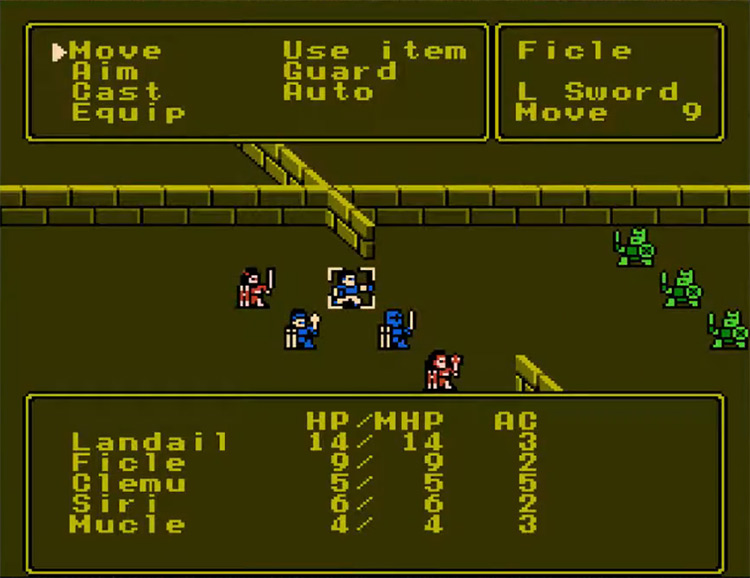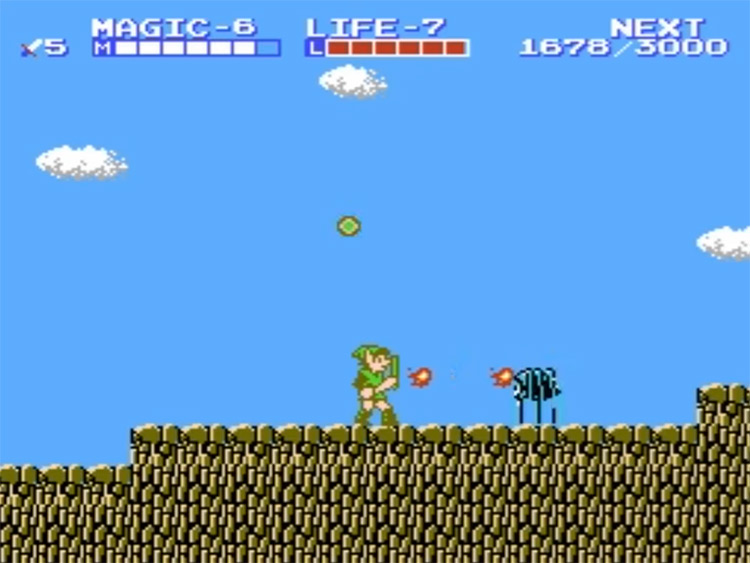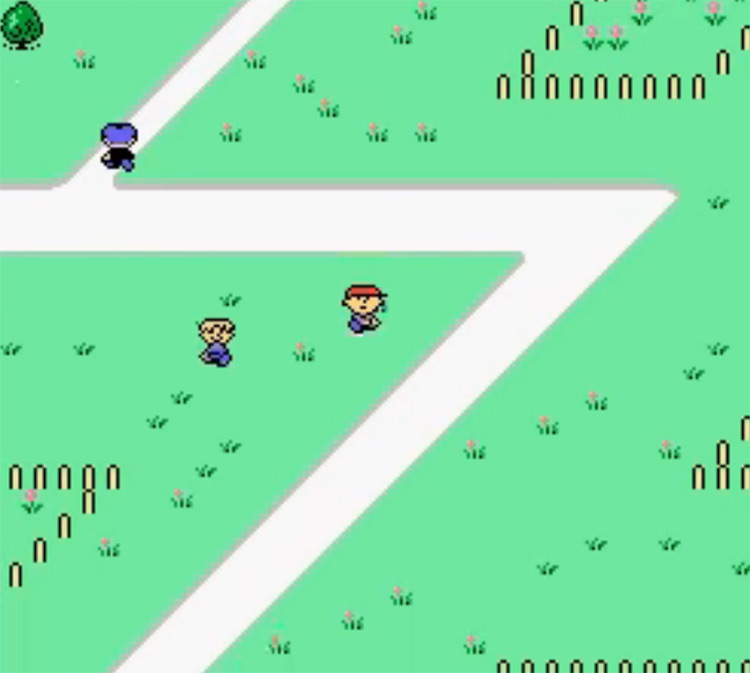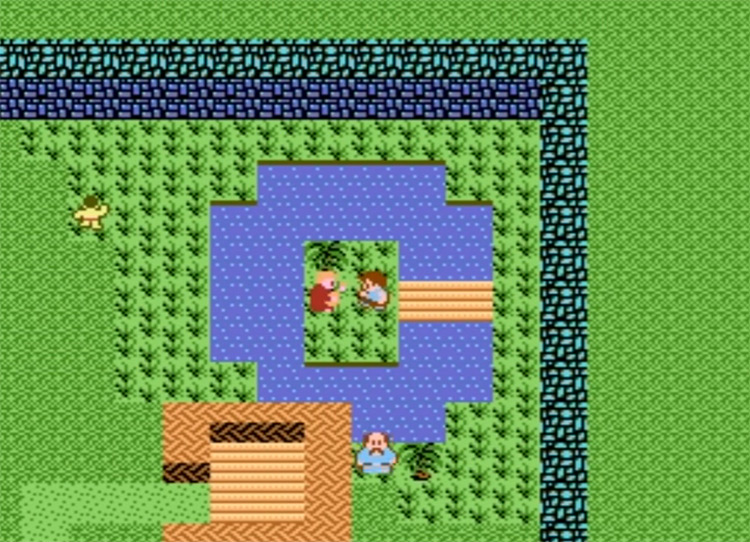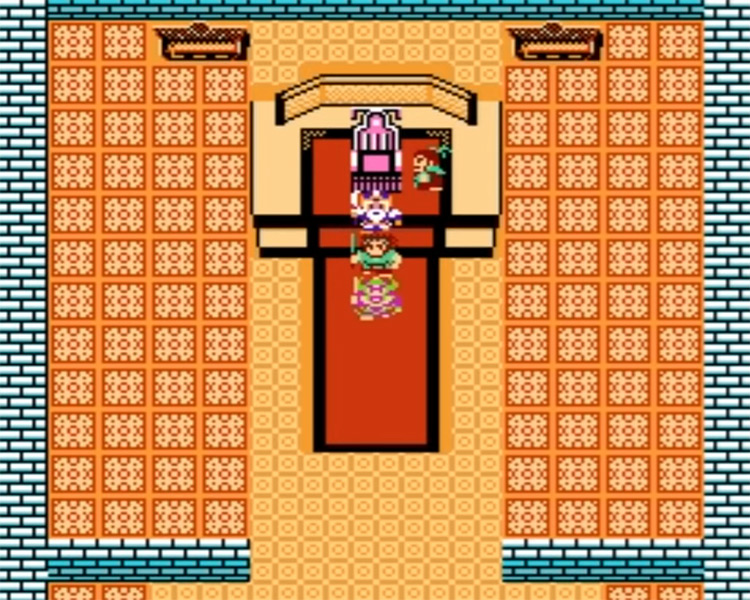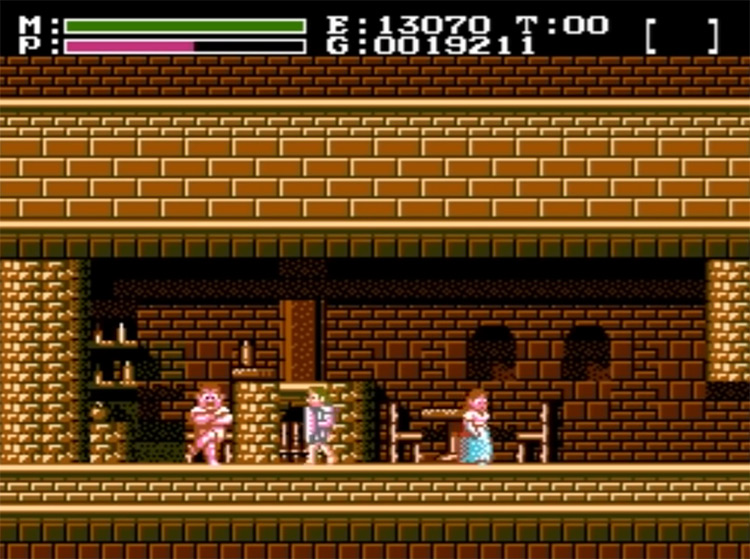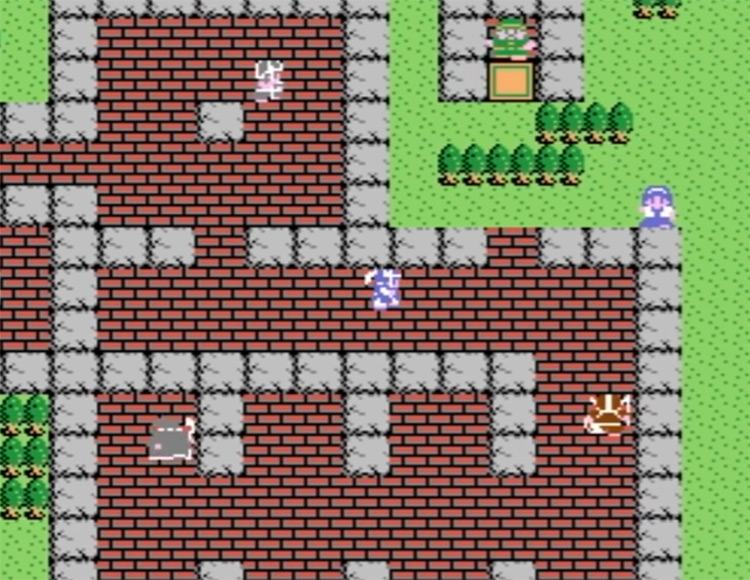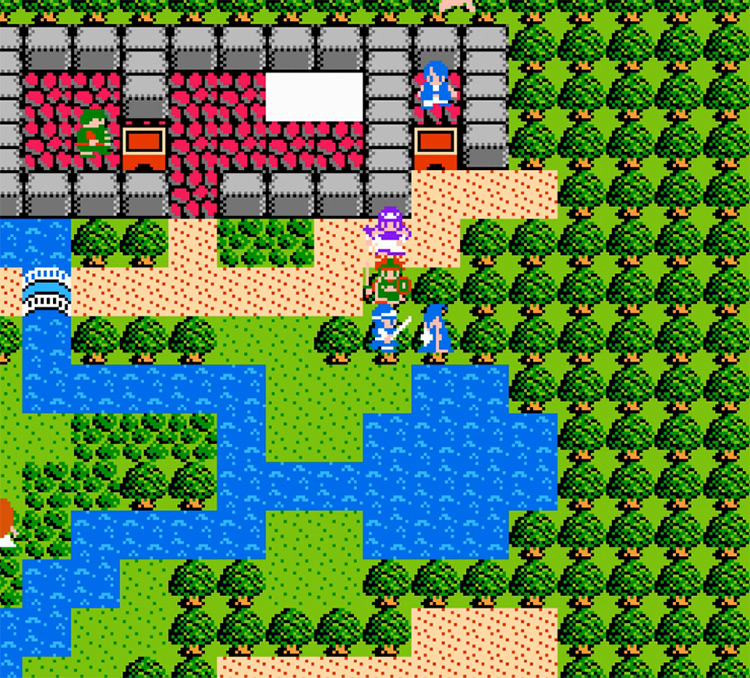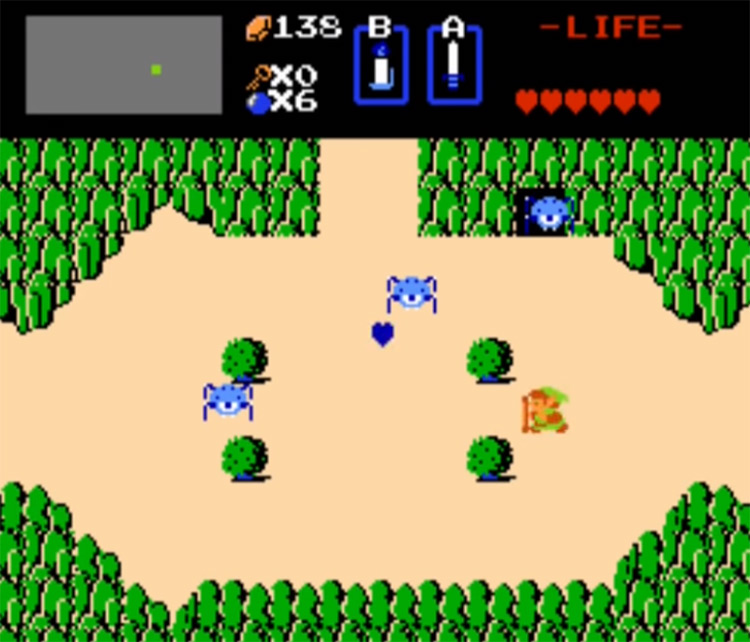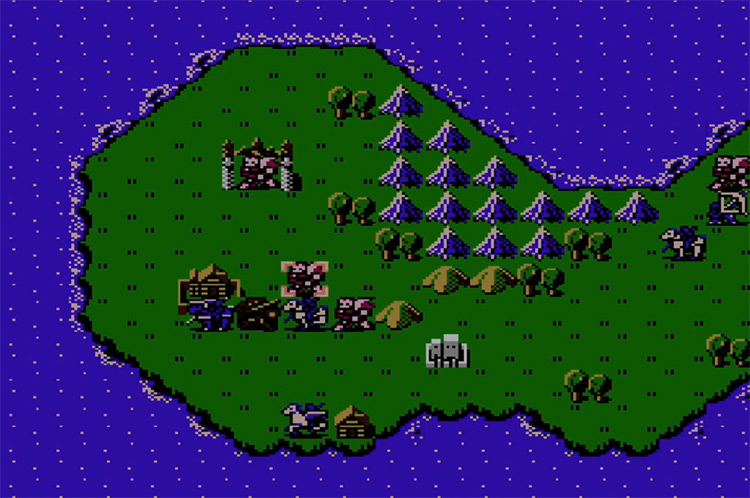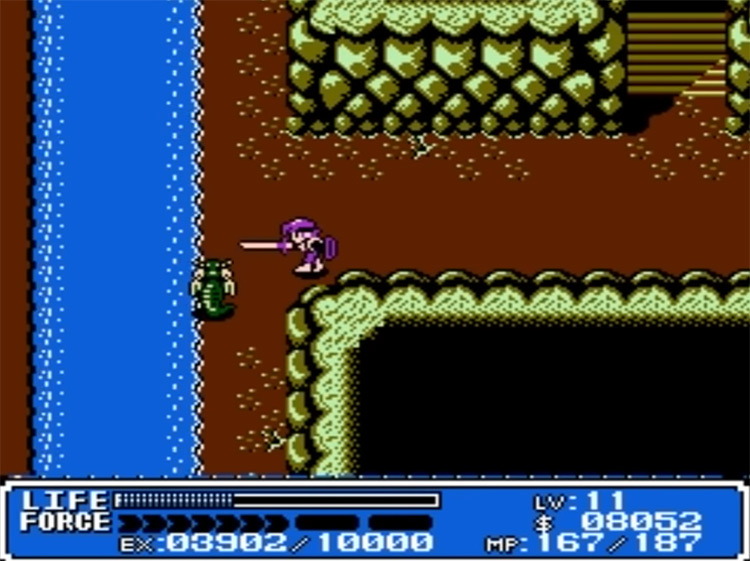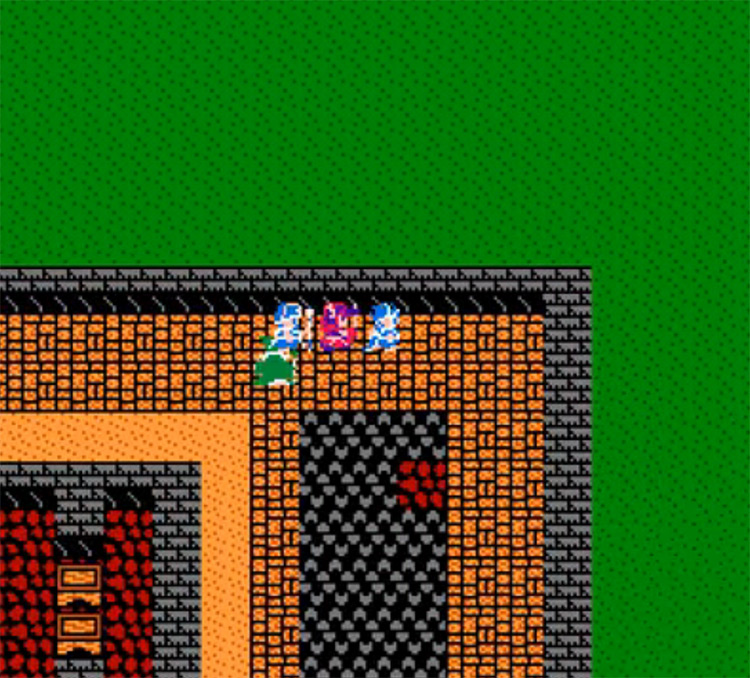And the RPG genre was doing just fine back in the 8-bit era too, despite lacking such sophisticated graphics. They got by with engaging stories, innovative gameplay, and the same vast, immersive worlds you could lose yourself into for days. The NES – and its Japanese counterpart, the Famicom – has an amazing RPG library, including some of the decade’s most important titles. It’s where Zelda and Final Fantasy got their start. And that’s only the tip of the iceberg. Let’s take a look at some amazing NES RPGs that shaped the industry we know and love today.
25. Willow (1989)
Released as a tie-in with Ron Howard’s 1988 film of the same name, Willow tells the story of Willow Ufgood – a farmer-turned-hero who takes up the sword to protect a newborn baby. The game is heavily inspired by top-down action RPGs like Zelda and Crystalis. You’ll explore several scenarios completing quests, fighting mythical creatures, gaining levels, and all of that good RPG stuff. Willow doesn’t innovate much or tell an especially compelling story – but it’s a competent Zelda-like game, and the graphics are pretty damn good (for the time).
24. Swords and Serpents (1990)
Swords and Serpents is a pretty typical high fantasy Western RPG offering challenging first-person dungeon crawling. You’ll control a party of adventurers exploring an underground dungeon where an evil serpent dwells. The graphics are nothing to write home about, and the story is barebones at best. But its tight gameplay makes it worth trying out if you get the chance.
23. Rainbow Silk Road (1991) (JP)
One of the most unusual inclusions in our list here is a relatively unknown game named Niji no Silkroad – or “Rainbow Silk Road” in English. What draws me to such an obscure Japan-only game is its gameplay, which places great focus on trading. To progress in the game, you need to invest your money wisely, buy items for cheap, and sell them at a profit the next town over. Really interesting mechanic for an early RPG. The game also features regular turn-based combat, but defeating enemies doesn’t award you experience. Rather, it gives you access to better merchandise to buy and sell at the local town. You can get a ROM translation here. Absolutely worth checking out if you’re a fan of the old school RPG aesthetic.
22. The Guardian Legend (1989)
One of my personal favorite games on the NES is The Guardian Legend, a fantasy/sci-fi title that brings together a top-down action RPG with an intense shoot-em-up. After awakening deep within Planet Naju, you’re tasked by its creators to find and deactivate ten safety devices scattered around the globe. You’ll get to explore Naju in a pretty non-linear fashion, taking in the impressive graphics and memorable sound effects.
21. Digital Devil Story: Megami Tensei (1987) (JP)
Digital Devil Story lets you persuade demons into joining your party. These powerful allies will help you as you make your way down an underground labyrinth in this first-person dungeon crawling gem. Unfortunately, the game never made it to the US – probably because of the dungeons’ quasi-religious aesthetic and references to Judaic and Christian lore (the final boss is, literally, Satan). You can find a fan translation here, and again it’s definitely worth the time. Especially for fans of the series.
20. Fire Emblem Gaiden (1992) (JP)
The Fire Emblem franchise has been a staple in my gaming habits for most of my life. So it’s only fitting I’d choose to include some FE titles in our NES ranking – even if they were never released outside of Japan. Fire Emblem Gaiden was the second game in the series. It brought many changes with it, including a world map with towns you can visit, the removal of weapon endurance, and much lower difficulty. All things considered, it’s a simplified take on the formula with better graphics and a bit more focus on the story. If you’re interested to try this out, you can get an English translation here, or play the 3DS remake – Fire Emblem: Shadows of Valentia.
19. The Magic of Scheherazade (1990)
One of the NES’s most underrated gems is The Magic of Scheherazade, an action-adventure RPG with turn-based combat that featured creative time-travel elements before it was cool. You’ll explore five different worlds fighting to rescue Princess Scheherazade and vanquish the evil wizard Sabaron. Other than the appealing visuals, the game shines for its varied gameplay and well-designed difficulty balance. You’ll feel challenged throughout the whole game, without it ever becoming frustrating.
18. Wizardry: Proving Grounds of the Mad Overlord (1990)
Most of the best RPG games on the NES were JRPGs. But some Western titles are well worth our attention, including the Wizardry series. This NES title is a direct port of the classic computer game released some years earlier. While some felt disappointed at the lack of innovation, many were happy to play it from the comfort of their sofa. The game is a fantasy adventure based on Dungeons & Dragons – like most WRPGs at the time – and despite its basic graphics, it had engaging gameplay with unforgiving difficulty that made you keep coming back to prove yourself in the dungeons beneath Trebor Castle.
17. The Bard’s Tale (1991)
If you’re looking for a timeless classic that’ll make you feel like it’s the 80s all over again, The Bard’s Tale is the way to go. The game is a first-person dungeon crawler with gameplay somewhat reminiscent of older text-based games. You’ll choose between six classes and lead your medieval squad through dangerous dungeons to defeat the evil Mangar and free the city of Skara Brae from his icy curse.
16. Sid Meier’s Pirates! (1991)
Most people – myself included – know Sid Meier’s Pirates! from the 2004 remake. This offered a fantastic and immersive (and updated) experience that let you choose your own pirate journey. So I was surprised to find its core aspects were already alive and well in the 1991 NES release of the original game. This open-world pirate adventure lets you sail the Caribbean as a pirate, a privateer for a colonial power, or even a dedicated pirate hunter. You’ll follow your captain through their entire seafaring career – down until the day when they retire and the game ends.
15. Ultima III: Exodus (1983)
Several years after its debut on desktop computer systems, Ultima III brought its classic turn-based RPG combat and creative puzzles to the NES. The game follows a party of heroes on a quest to defeat Exodus, a demonic AI-controlled machine terrorizing the world of Sosaria (which we also visit in the first game). To do so, they’ll have to find four magic cards that’ll deactivate the robotic beast. Compared to the previous releases, Ultima III on the NES is a pretty unique experience. The biggest difference has to be graphics, which forego the original design for a more “standard” JRPG look. It’s a bit generic, but I think they’re fantastic in their own right.
14. Ultima IV: Quest of the Avatar (1985)
After Ultima III, the series took a weird turn. Instead of a band of warriors on a quest to defeat a great evil, Ultima IV casts you as the Avatar – a sort of religious leader who must develop eight virtues to reach enlightenment and save the people’s hearts from corruption. In other words, it’s Jesus Christ Simulator 1985. This change of focus made this turn-based RPG one of the most unique on the NES. Other than fighting, you’d develop your virtues by talking to NPCs and helping them out. In a way, it’s pretty similar to the Persona franchise’s social simulation elements.
13. Pool of Radiance (1992)
The first-ever video game adaptation of the Advanced Dungeons and Dragons pen-and-paper role-playing game came in the form of Pool of Radiance, one of the best NES RPGs made in the West. The first-person dungeon crawling was exquisitely done and quite challenging. It’s a little complex for RPG newcomers to enjoy, but genre veterans will love it. One of the best things about Pool of Radiance back in the day is that it included a built-in save system rather than just using passwords like most other RPGs at the time. This was pretty innovative for its day, honestly.
12. The Legend of Zelda II (1988)
After the massive success of The Legend of Zelda, Nintendo decided innovation was the key to repeating the feat – and so, The Legend of Zelda II was born. This unique game in the Zelda franchise changes the top-down action for a side-scrolling adventure, somewhat reminiscent of Metroid. While the game introduced several staples of the Zelda series, such as the magic meter, this change to side-scrolling levels wasn’t the brightest idea. That’s just no way of exploring Hyrule! And I’m not alone – this might be the most controversial game in the whole LoZ franchise. Still, it remains an incredibly high-quality game, and a meaningful entry in Zelda’s history. It’s also a direct sequel to the first game, so you’ll want to play it if you ever want to know the whole story (or if you’re just a completionist).
11. Mother (1989) (JP)
Everyone knows EarthBound thanks to its slow rise to fame after Nintendo included Ness in the original Super Smash Bros. But did you know EarthBound the prequel? Mother – later released in the Wii’s virtual console as EarthBound Beginnings – is a turn-based RPG that chose to do away with medieval knights and demon lords. Instead, it takes place in Eagleland – a fictional realm inspired by the late 20th Century USA. After a robot invasion overruns their town, it’s up to Ninten and his friends to stop them with their psychic powers. If you like EarthBound (AKA Mother II) then you owe it to yourself to get an English translation for the original ROM (try here). Playing the original is best for true nostalgia, but you can always boot up EarthBound Beginnings on the Virtual Console instead.
10. StarTropics (1990)
Another incredible top-down action RPG inspired by TLoZ that’s worth your time is StarTropics, which makes you fight vicious, blood-thirsty beasts with… baseballs? The game casts you as Mike Jones, a pitcher from Seattle who’s visiting his grandpa down in the tropics. Upon finding out he’s been kidnapped, Mike sets out on a dangerous rescue mission that’ll pit him against zombies, giant worms, ancient automatons, and more. StarTropics’ “shooter” combat really sets it apart from most top-down adventures. And the puzzles littered throughout the dungeons are pretty challenging.
9. Destiny of an Emperor (1990)
Destiny of an Emperor takes place during the Three Kingdoms era in China’s history. It follows the legendary Liu Bei as he grows his army from a small militia to a force capable of restoring the Han dynasty. This tactical RPG is a refreshing take on the genre thanks to its large-scale battles and innovative mechanics, including an enemy recruitment system. There’s also an “All Out” mode that’ll let you blast through a battle without any input if you feel your units are overpowered enough. The game features around 150 recruitable characters, too. It may seem like a lot, and it kinda is for NES days, but they can really drop like flies if you abuse the All Out mechanic.
8. Faxanadu (1989)
Fans of the Dragon Slayer series might find some of the same appeal in Faxanadu, a gorgeous-looking spin-off on the NES. After weeks of monsters laying siege to the Elven city of Eolis, water and food are running out. You’ll journey to the World Tree in search of a way to purify the poisoned springs surrounding Eolis. The gameplay is similar to Legend of Zelda II, with a higher focus on platforming – making it essential for platformer and RPG aficionados alike.
7. Dragon Warrior (1989)
The first game in Chunsoft’s famed Dragon Quest saga was localized to North America as Dragon Warrior – and it instantly became a hit among RPG enthusiasts. This seminal turn-based RPG was inspired by games like Ultima, but sought to emphasize compelling storytelling and detailed world-building. The gameplay isn’t innovative by any stretch of the imagination. This was original NES, after all. But the characters are well-written and developed, the lore is immersive, and the graphics are a total treat. Absolutely worth a playthrough for hardcore fans of the series.
6. Dragon Warrior II (1990)
After the original Dragon Warrior’s resounding success, the DQ series released a second title. And it was quickly localized for the international market. The story in this sequel takes place 100 years after the original. This time around, you’ll put on the shoes of the Prince of Midenhall and lead your party against the evil wizard Hargon. The game improves on the original by creating a larger overworld with more diverse areas and more varied characters. You can also sail around in your very own ship, which adds to the sense of adventure. As a whole, this title is just an incredible RPG all-around. Worth a try even if you’ve never played any Dragon Quest games, but just want a taste of retro gaming.
5. The Legend of Zelda (1986)
Lots of Zelda fans love to waste time arguing over whether it’s an RPG or not. I won’t worry about such matters. It’s a fantastic game with some serious RPG elements, and I love it. The first Zelda game is one of the finest 8-bit games ever made, and possibly the most influential in the genre next to Final Fantasy. Countless games would try to emulate its dynamic top-down action back in the day. And even today it still inspires awesome games like The Sword of Ditto (2018). It’s a real classic. If you’ve never taken the sword from the old man, reunited the 8 pieces of the Triforce of Wisdom, or defeated Ganon, you owe it to yourself to play this ASAP.
4. Fire Emblem: Shadow Dragon and the Blade of Light (1990) (JP)
International audiences didn’t get to know the Fire Emblem franchise until the eponymous GBA title was released. By that point, it had already established itself in Japan – beginning with Shadow Dragon on the NES. Here you’ll command units on grid-based maps as Prince Marth, and retake your rightful place on the throne from the dastardly wizard Gharnef and his evil sponsor – Medeus, the Shadow Dragon. One of this game’s main contributions to tactical RPG gameplay was perma-death, which forced you to take better care of your units, protect them, and retreat when necessary. This game was really tough to play until somewhat recently, when Nintendo finally released it outside of Japan for the Nintendo Switch.
3. Final Fantasy (1990)
Whenever I hear the word “RPG”, the original Final Fantasy always pops into my mind for a fraction of a second. It’s the game that taught me what a JRPG was. And it shaped my gaming habits for the rest of my life. The story is simple: Four Light Warriors must oppose the evil that’s covered the world in darkness. They do this by awakening the four elemental orbs. If that sounds similar to any other JRPG you’ve played, it’s because Final Fantasy became the gold standard after its release. And everyone wanted to emulate its success. The same goes for the fantastic class system in this original title, plus the massive open world, and the introduction of fast travel, which became industry staples after Final Fantasy’s release. And if you want to skip the NES version of this, you can try the GBA port version instead.
2. Crystalis (1990)
Crystalis is a fantastic action RPG that never ceases to give fans something to talk about. The story is good, the gameplay is innovative, and overall, the game seems ahead of its time. Similar to Fallout, we learn that Crystalis takes place after modern society was wiped out by nuclear war. Now magicians keep the peace in this new era of sword and sorcery – until the evil sorcerer Draygon takes over. And it’s up to you to set out on a Zelda-esque adventure to find the four Elemental Swords and bring them together to form the Crystalis – the only weapon that can stand up to Draygon.
1. Dragon Warrior III (1992)
This penultimate Dragon Quest title released abroad under the localized name “Dragon Warrior” was the last in the Erdrick Saga. And one of the very best games on the NES ever made. This classic turn-based RPG casts you as the 16-year-old son of a famed Hero, who sets out on a quest to rid the world of the evil Archfiend Baramos and save the realm of Aliahan from ruin. It’s hard to find fault with anything in DW III. But the game definitely shines for its deep world-building, and the way it neatly wraps-up the last three games’ stories. You even get to visit the world of the very first DW game at some point! No spoilers, though.
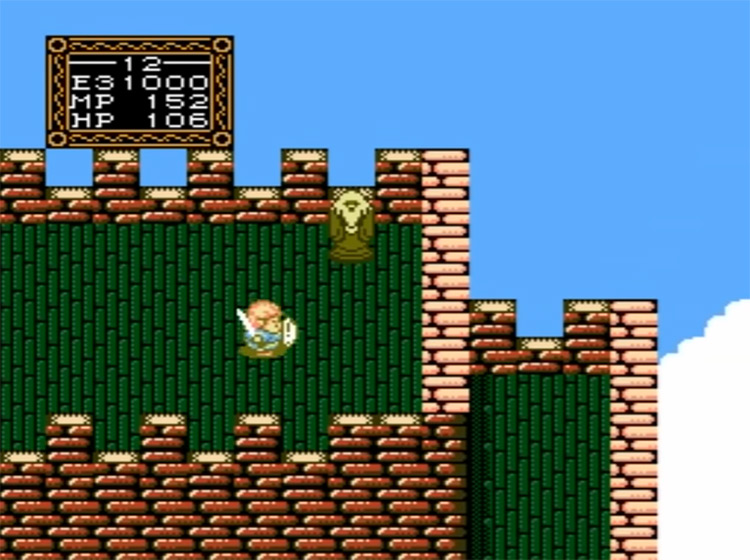
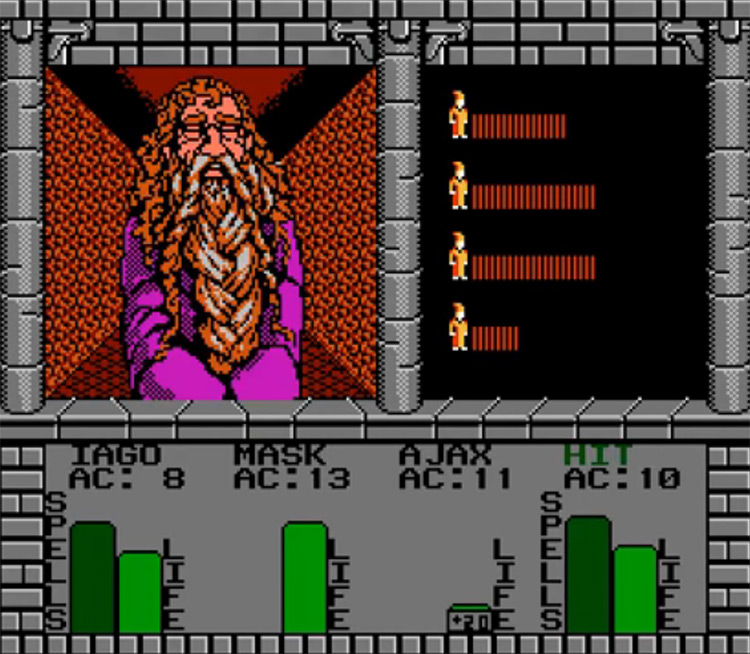
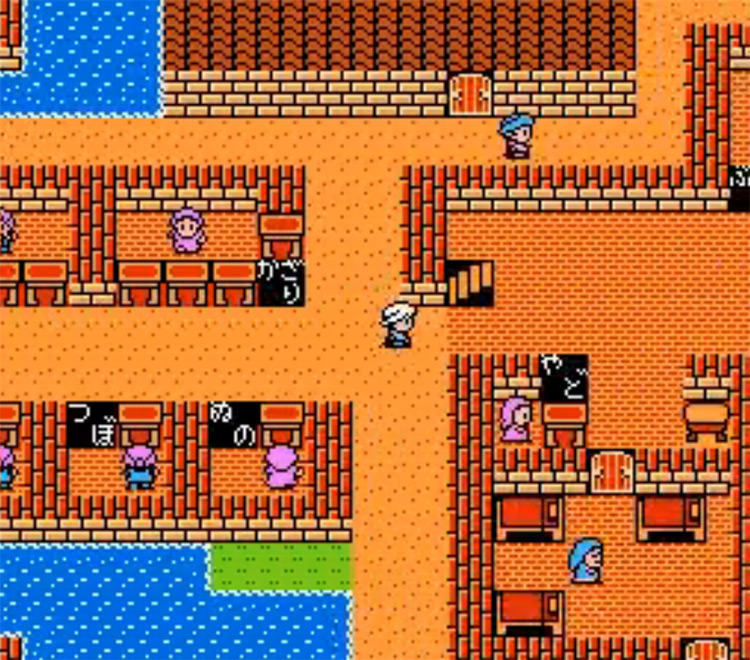
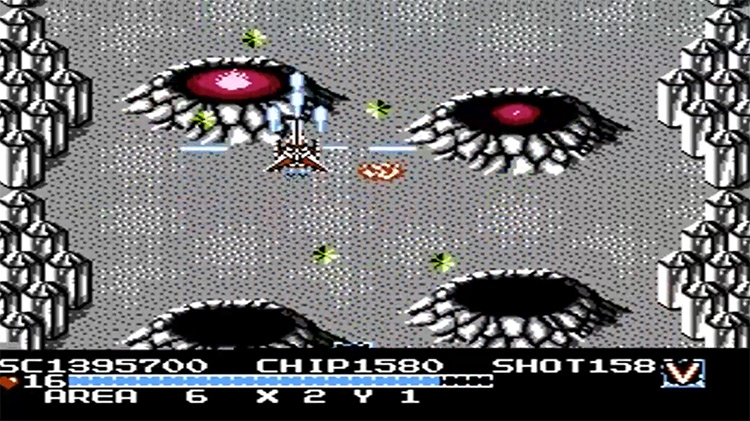
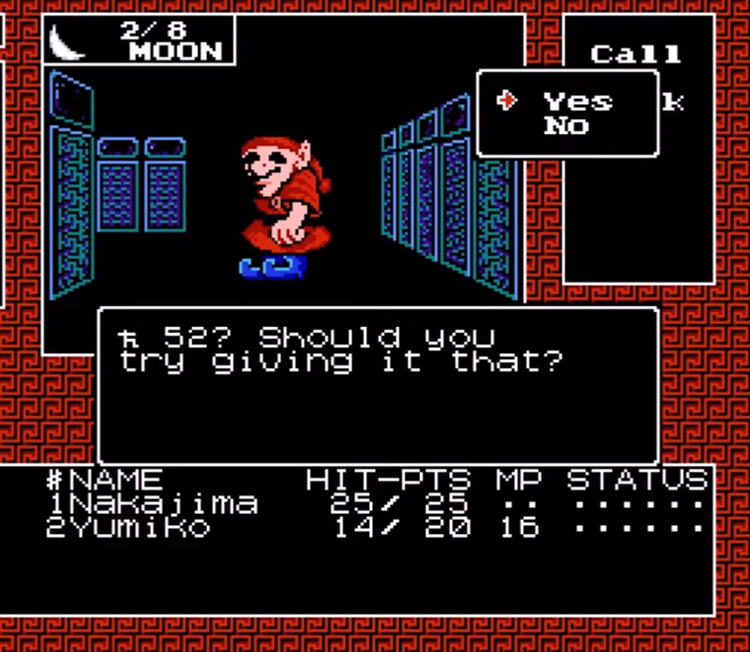
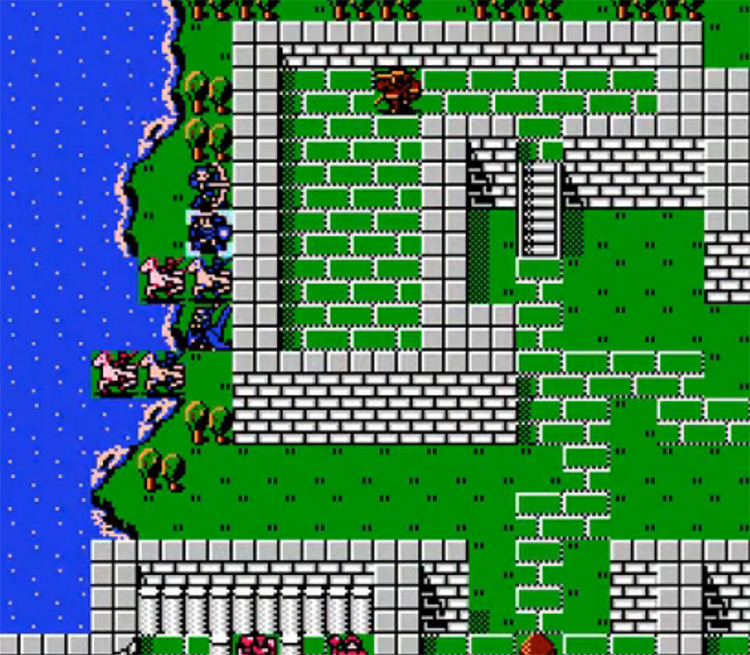
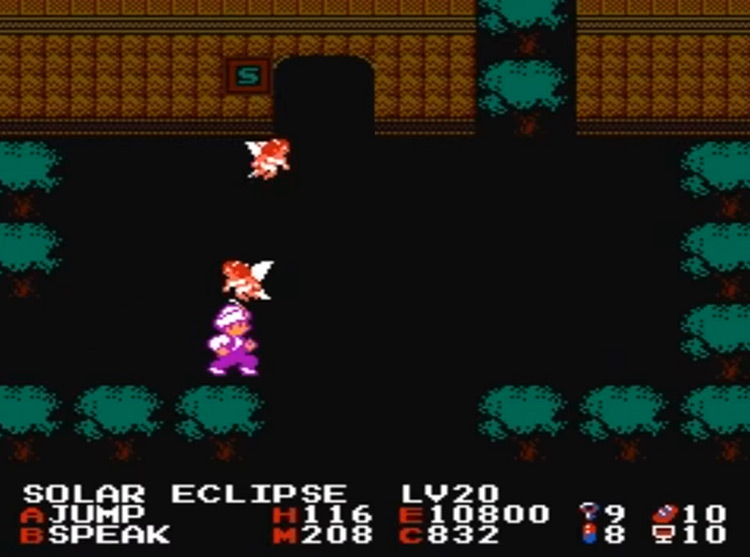
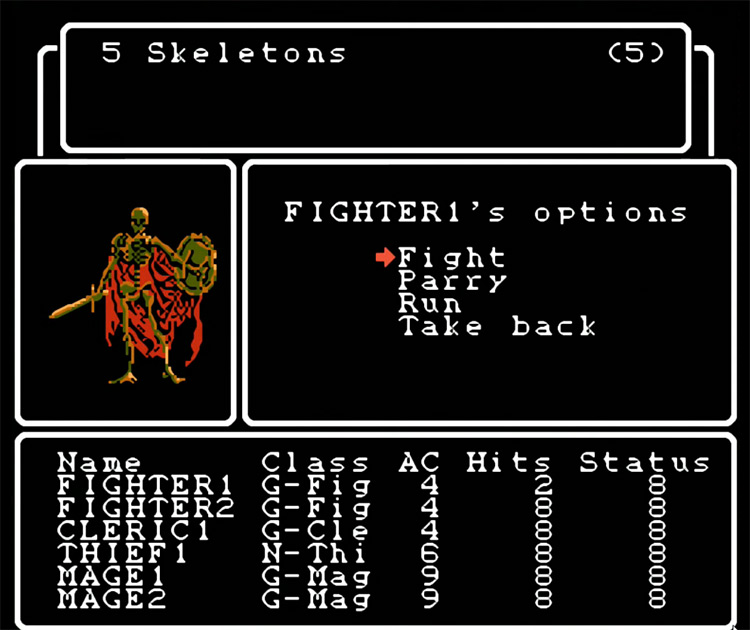
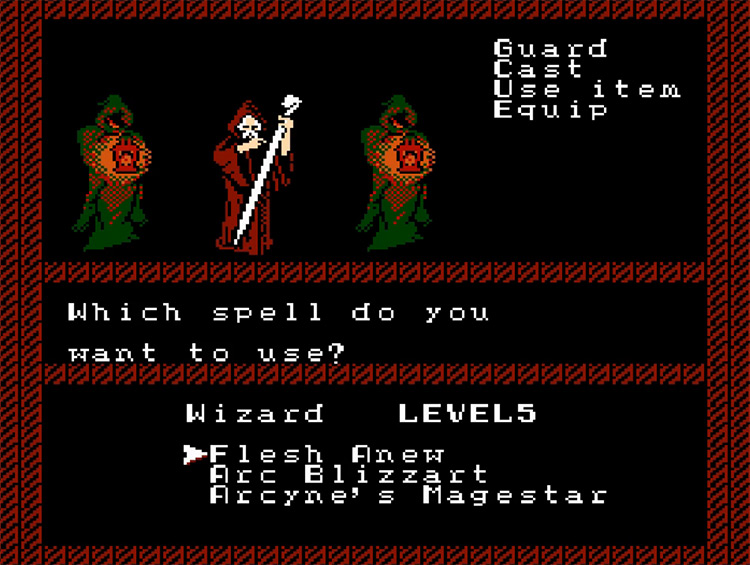
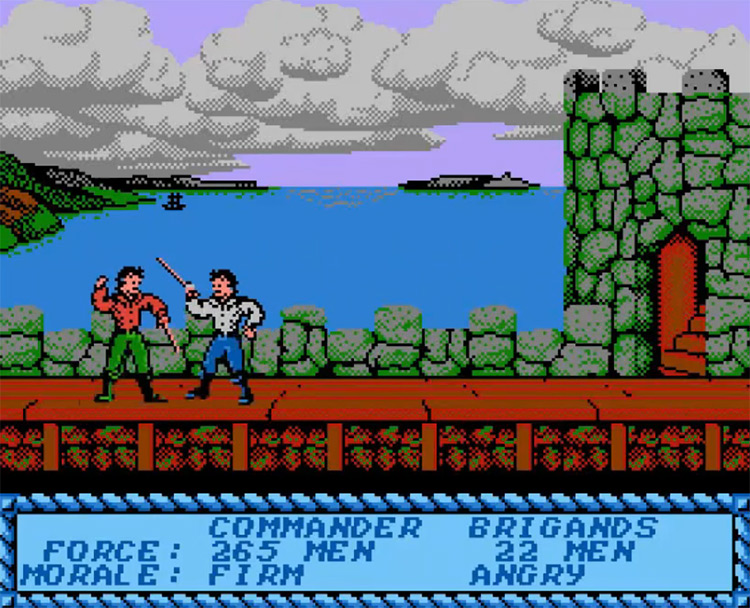
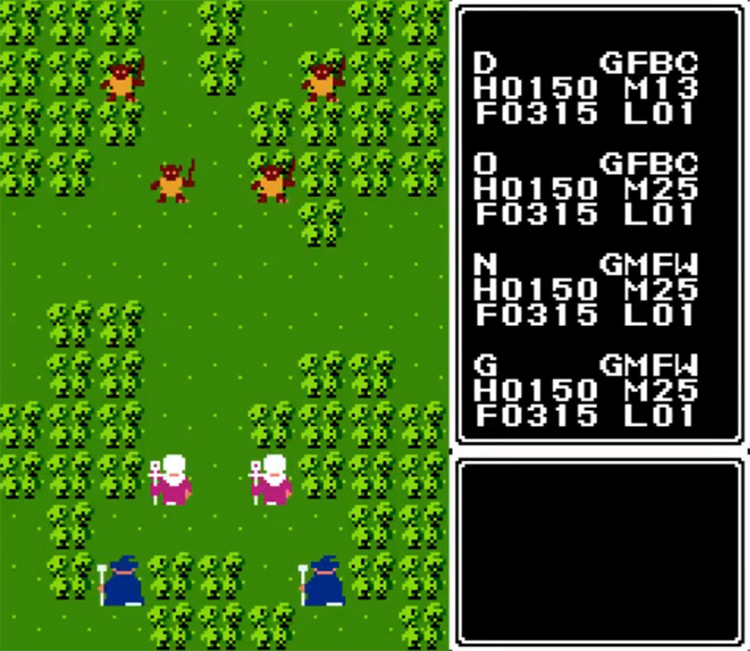
![]()
